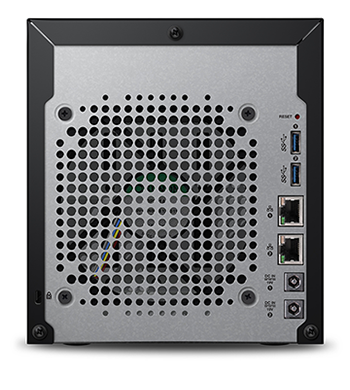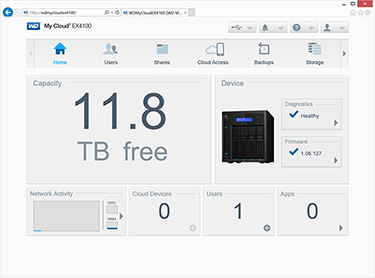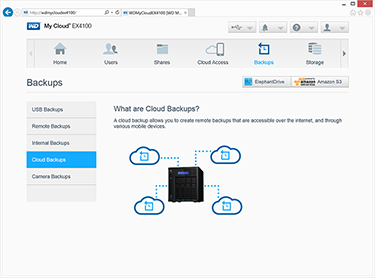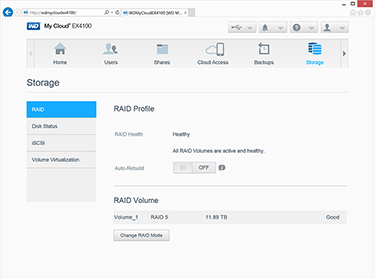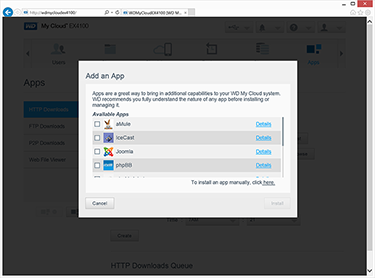Introduction
WD is fast becoming a serious player in the world of network-attached storage (NAS). Following on from the launch of the original My Cloud back in late 2013, the storage specialist has gone on to expand its portfolio with the consumer-oriented My Cloud Mirror and the prosumer My Cloud EX Series.
It's fair to say that WD has found its feet after early teething issues, and the company is now hitting its stride with the launch of four new additions targeting the higher end of the market. For prosumers, the new two-bay EX2100 and four-bay EX4100 tout "top of their class read/write speeds" and, for businesses, the expandable DL2100 and DL4100 offer Intel processing and the promise of "reliability, security and scalability."
All four continue to run the evolving Linux-based WD My Cloud operating system, and it's the prosumer EX4100 that's under the microscope today.
Priced from £350, the EX4100 is available as a diskless unit or pre-equipped with NAS-optimised WD Red hard disks in 8TB (2x4TB), 16TB (4x4TB) and 24TB (4x6TB) capacities. WD Reds are the only officially supported drives, so buying a populated model makes sense, and as an added incentive WD offers a three-year warranty on the 8TB, 16TB and 24TB units, compared to a standard two years for the diskless variant.
Build quality and presentation are good, with WD taking a business-like approach, and we like the fact that all four hot-swappable drive bays are tool-free. Disks slide in effortlessly, though, do be aware that there is no locking mechanism to prevent unauthorised access and 2.5in disks aren't catered for.
Making good use of the available space, the front of the metal 170mm x 232mm x 192mm chassis includes an easy-access USB 3.0 port as well as a backlit, two-line LCD display for status updates and alerts. The bulk of the connectivity options are tucked neatly around back and include a further two USB 3.0 ports, dual Gigabit Ethernet with support for Link Aggregation, and dual power ports for an optional second supply. A single 120mm fan is tasked with keeping the box running cool, and does so without producing much noise - the entire unit keeps reasonably quiet during use.
Under the hood, WD has equipped the EX4100 with a dual-core 1.6GHz Marvell Armada 388 processor and 2GB of DDR3 memory. That's a step-up from the 1.3GHz chip and 1GB of memory featured in the dual-bay EX2100, but note that the EX Series' memory isn't expandable - that's a feature reserved for the DL Series. According to the marketing material, however, the EX4100's components should be ample with quoted read and write speeds of up to 116MB/s.
As with any NAS, the software is every bit as important as the hardware. There's always been a sense that the My Cloud operating system is playing catch up to the likes of Qnap's QTS and Synology's DSM, but WD is making meaningful progress and at v1.06, the software is looking increasingly competitive.
The setup wizard can be completed in a matter of seconds, and if you purchase a model populated with drives, a RAID array is already configured to get you up and running immediately. Our 16TB review sample is setup in RAID 5 (JBOD, 1 or 10 are also available), and administration is carried out via a slick web-based user interface that feels intuitive and responsive.
WD has been dotting the i's and crossing the t's in terms of NAS functionality, and the bulk of what you'd expect is now present and accounted for. For regular consumers, there's a built-in DLNA media server, a range of My Cloud mobile apps for iOS and Android, simplified Cloud Access, scheduled power on/off and automatic disk spin-down to help conserve energy.
Data security is equally well-managed, with the EX4100 supporting backups to another My Cloud device, an attached USB device, or a cloud-based service such as Amazon S3. Apple Time Machine is also supported, and with WD's own SmartWare Pro utility, it's easy to create backup images of entire PCs.
With a prosumer audience in mind, WD has included support for Microsoft Active Directory, iSCSI targets, network UPS devices, integrated FTP and the Simple Network Management Protocol. Everything a budding NAS box needs, yet while the EX4100 is shaping up to be a solid choice for creative professionals and enthusiast home users, the feature set isn't quite as comprehensive as the competition.
Third-party apps have been introduced to help close the gap - these include aMule, phpBB and WordPress, among others - but the My Cloud OS still has some catching up to do. Built-in anti-virus and a surveillance package are two notable omissions, and it'll be interesting to see if the minimalistic My Cloud interface will be able to include such extra features without a complete UI overhaul.
WD has upcoming software features, that we aren't yet able to disclose, at the top of its priority list, but in the meantime, let's see if performance is up to scratch.







